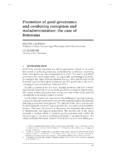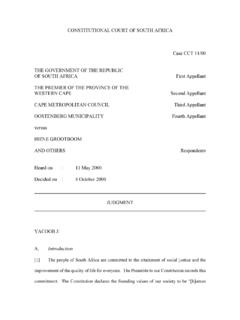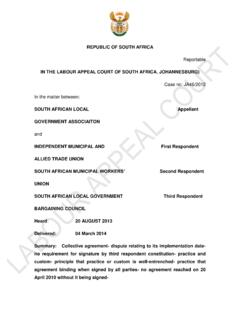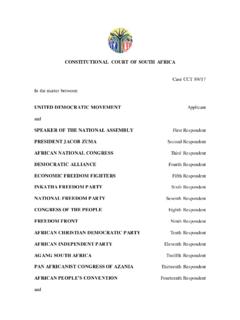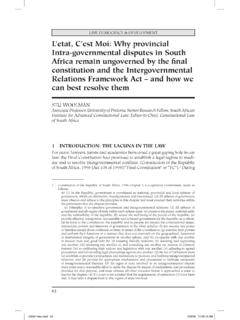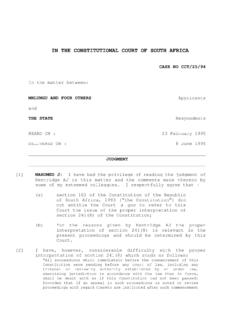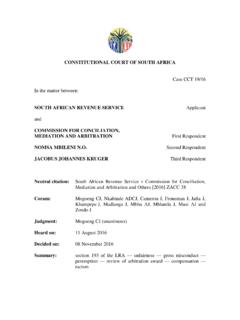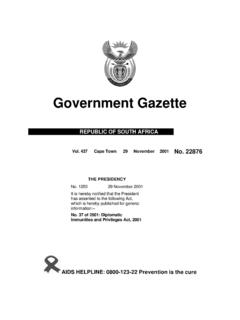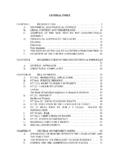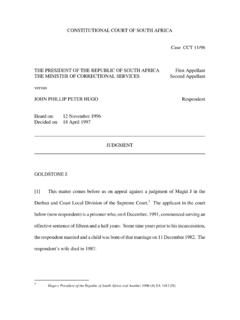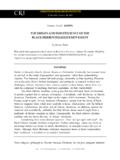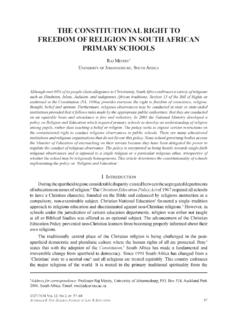Transcription of THE SUPREME COURT OF APPEAL OF SOUTH …
1 THE SUPREME COURT OF APPEAL OF SOUTH africa JUDGMENT Reportable Case No: 107/12 In the matter between: DEPARTMENT OF CORRECTIONAL SERVICES First Appellant AREA COMMISSIONER: POLLSMOOR Second Appellant MANAGEMENT AREA and POLICE AND PRISONS CIVIL RIGHTS First Respondent UNION (POPCRU) EGANAMANG JAMES LEBATLANG Second Respondent THAMSANQA RUSSEL NGQULA Third Respondent LUCKY THAMSANQA KAMLANA Fourth Respondent COHEN JACOBS Fifth Respondent MDUDUZI KHUBHEKA Sixth Respondent Neutral citation.
2 Department of Correctional Services & another v POPCRU & others (107/12) [2013] ZASCA 40 (28 March 2013) Coram: NUGENT, MAYA, and PILLAY JJA, PLASKET and MBHA AJJA Heard: 19 FEBRUARY 2013 Delivered: 28 MARCH 2013 2 Summary: Labour Relations Act 66 of 1995 section 187(1)(f) departmental dress code prohibiting wearing of dreadlocks by male correctional officers whether dismissal of Rastafari and Xhosa respondents for refusing to cut their dreadlocks worn in observance of sincerely held religious and cultural beliefs discriminatory and automatically unfair on grounds of religion, culture and gender meaning of s 187(2)(a).
3 _____ ORDER _____ On APPEAL from: the Labour APPEAL COURT , Cape Town (Murphy AJA, Waglay DJP and Davis JA sitting as COURT of APPEAL ). The APPEAL is dismissed with costs that include the costs of two counsel. _____ JUDGMENT _____ MAYA JA (NUGENT, PILLAY JJA, PLASKET AND MBHA AJJA concurring) [1] This is an APPEAL from a judgment of the Labour APPEAL COURT ( the LAC , per Murphy AJA, Waglay DJP and Davis JA concurring), with special leave of this COURT . The LAC upheld the decision of the Labour COURT (Cele J) that the dismissals of the second to sixth respondents (the respondents) were automatically unfair as contemplated in section 187(1)(f) of the Labour Relations Act 66 of 1995 (the LRA).
4 As a basis for its conclusion, the Labour COURT had found that the respondents were unlawfully subjected to gender discrimination. On APPEAL , the LAC added two grounds of discrimination, religion and culture, as further support for the finding. 3 [2] The facts are largely common cause. The respondents are male former correctional officers of the first appellant (the department). All were members of the first respondent, a trade union, and held various positions at Pollsmoor Prison, Cape Town (Pollsmoor) at the time of their dismissals in June 2007.
5 They each had long service with the department and were exemplary employees. A common feature among them was their hairstyle. They all wore dreadlocks albeit for different reasons. It is their refusal to cut their hair when ordered to do so under the department s Corporate Identity Dress Code (the dress code) that led to their dismissals and these proceedings. [3] The dress code made provision, in clause 5, for Personal appearance relating to wearing of jewellery, make-up, moustaches and beards and hairstyles.
6 Clause dealt pertinently with hairstyles and read: Hairstyles The following guidelines are [laid] down for the hairstyles of all Departmental officials. In judging whether a hairstyle is acceptable, neatness is of overriding importance. Hairstyles: Female officials Hair must be clean, combed or brushed and neat at all times (taken good care of). Unnatural hair colours and styles, such as punk, are disallowed. Hairstyles: Male officials Hair may not be longer than the collar of the shirt when folded down or cover more than half of the ear.
7 The fringe may not hang in the eyes. Hair must always be clean, combed and neat at all times (taken good care of) Hair may not be dyed in colours other than natural hair colours or cut in any punk style, including a Dreadlocks hairstyle. No decorations ( beads, clips) May be worn on the hair. 4 It is the Rasta man hairstyle prohibition in clause that the respondents contravened. [4] Until the appointment of the second appellant as area commissioner of Pollsmoor on 15 January 2007, there does not appear to have been any clear guide in the institution about the enforcement of the dress code and other departmental policies pertaining to discipline and security.
8 There had been no objection whatsoever to the respondents hairstyle which was also sported by a handful of women correctional officials. [5] The commissioner immediately set about bringing sweeping changes to tighten controls and bring the prison to order. On 18 January 2007 he convened a meeting with the prison personnel and managers. Various issues relating to compliance with departmental policies, performance management and human resource management were discussed. Chief on the agenda were the commissioner s concerns about security risks and the flouting of the dress code and other policies in the institution.
9 Following the deliberations, he issued a written instruction on the next day directing correctional officers to attend to their hair in compliance with the dress code or advance reasons by 25 January 2007 why corrective action should not be taken against them. Some of the officers abided the instruction and some of those who wore dreadlocks promptly cut their hair to meet the requirements set out in the dress code. The respondents did not. [6] On 26 January 2007 the commissioner wrote to ask them to give reasons why they should not be suspended for contravening the dress code.
10 Their responses were varied. Messrs Lebatlang, Jacobs and Khubheka attributed their hairstyle to their Rastafarian religion. They said 5 their hairstyle, an outward manifestation of the religion, did not prejudice the department s interests. The instruction to cut their hair undermined their freedom of religion, which was recognised and protected by the Constitution, and constituted unfair discrimination on that basis. [7] Messrs Ngqula and Kamlana gave cultural reasons for their hairstyle. Mr Ngqula said he wore his dreadlocks to obey his ancestors call, given through dreams, to become a sangoma or traditional healer in accordance with his Xhosa culture.
